七年级英语上册所有知识点
七年级英语上册知识点笔记
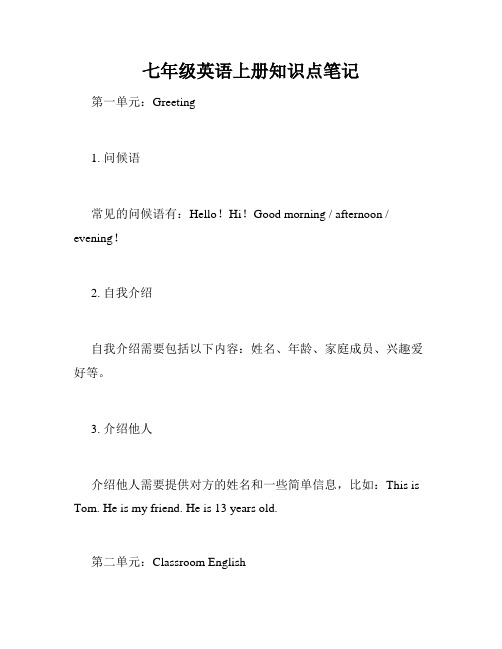
七年级英语上册知识点笔记第一单元:Greeting1. 问候语常见的问候语有:Hello!Hi!Good morning / afternoon / evening!2. 自我介绍自我介绍需要包括以下内容:姓名、年龄、家庭成员、兴趣爱好等。
3. 介绍他人介绍他人需要提供对方的姓名和一些简单信息,比如:This is Tom. He is my friend. He is 13 years old.第二单元:Classroom English1. 教室用语教室用语包括:Sit down, please. Stand up. Open your books. Close your books. Listen carefully. Pay attention. Raise your hand. Can I go to the bathroom?2. 课程内容常见的课程内容有:English, math, music, art, P.E.等。
第三单元:Family1. 家庭成员家庭成员包括:dad, mom, brother, sister, grandfather, grandmother等。
2. 家庭关系常见的家庭关系有:my dad / mom is my parent. My brother / sister is my sibling. My grandfather / grandmother is my grandparent.第四单元:School life1. 学校设施学校常见的设施包括:classroom, library, playground, canteen, gym等。
2. 学校活动学校常见的活动包括:field trip, sports day, school concert, school trip等。
第五单元:My day1. 时间时间的表达方式包括:What time is it? It's seven o'clock / half past eight / quarter to ten.2. 日常活动常见的日常活动包括:get up, have breakfast / lunch / dinner, go to school, do homework, watch TV, play sports等。
七年级上册英语各单元知识点归纳

七年级上册英语各单元知识点归纳Unit1Myname’sGina.Ⅰ.重点词语:1.myname我的名字2.yourname你的名字stname/familyname姓4.firstname/givenname名5.IDcard身份证6.schoolIDcard学生卡7.answerthequestions回答问题8.telephone/phonenumber电话号码9.addressbook电话号码薄Ⅱ.重点句型:1.---What’syourname?你叫什么?---Mynameis…/I’m…我是……2.Nicetomeetyou./I’mgladtomeetyou.见到你很高兴。
3.---What’syourtelephone/phonenumber?你的电话是多少?---Mytelephone/phonenumberis……我的电话是……4.---What’syourfamily/lastname?你的姓是什么?---Myfamily/lastnameis…我姓…5.---What’syourgiven/firstname?你的名是什么?---Mygiven/firstnameis…我的名是…Unit2Isthisyourpencil?Ⅰ.重点词语:1.yourpencilcase/pencilbox你的铅笔盒2.myeraser我的橡皮3.hernotebook她的笔记本4.hisbackpack他的双肩包5.Mike’sdictionary迈克的字典6.mymathbook我的数学书7.inEnglish用英语8.inChinese用汉语9.lostandfound失物招领putergame电脑游戏11.asetofkeys一串钥匙12.lookforⅡ.重要句型:1.Isthisyourpencil?Yes,itis.这是你的铅笔吗?是我的。
2.Isthathereraser?No,itisn’t.那是她的橡皮吗?不,不是。
七年级上册英语知识点

七年级上册英语知识点七年级英语上册知识总结Unit 1:My name's Gina.第一单元我们学习了部分人称代词主格和形容词性物主代词。
具体内容,请看下图趣解语法✍人称代词主格在句中作主语,是整个句子的龙头老大。
注意点:但值得注意的是:I 作主语时,be 动词用am;she/he/it 作主语时,be 动词用is。
英语人称代词用法口诀:人称代词主宾格,作用不同莫用错。
主格动词前做主,动词介词后宾格。
You和it主宾同,其他主宾须分清。
人称代词并列现,尊重他人礼当先。
单数人称二三一,复数人称一二三。
若把错误责任担,第一人称我靠前。
✍形容词性物主代词具有形容词的特性,常放在名词前面作定语,表明该名词所表示的人或物是"谁的"所以我不能单独使用,其后必须跟名词。
比如:my name; your friend……英语物主代词用法口诀:物主代词分两种,形容词性名词性。
形容词性能力差,自己不能来当家。
句子当中作定语,身后定把名词加。
物主代词名词性,相当名词可单用。
句中充当主宾表,身后没有名词影。
两种代词形不同,添个s 形变名。
his,its不用变,my变mine要记清。
话不多说,我们给大家来一些例证吧!✍经典例句1人称代词主格1. I am a girl. 我是一个女孩。
2. He/She is my friend. 他/她是我的朋友。
3. You are very nice. 你非常好。
4. It is a bed. 它是一张床。
2形容词性物主代词5. My name is Mary. 我的名字叫玛丽。
6. Your room is so tidy. 你的房间很整洁。
7. This is his/her pen. 这是他/她的钢笔。
8. That is my dog. Its name is Susan.那是我的狗。
它的名字叫苏珊。
9.He's a student. His mother is a teacher.他是一名学生。
初一上册英语知识点
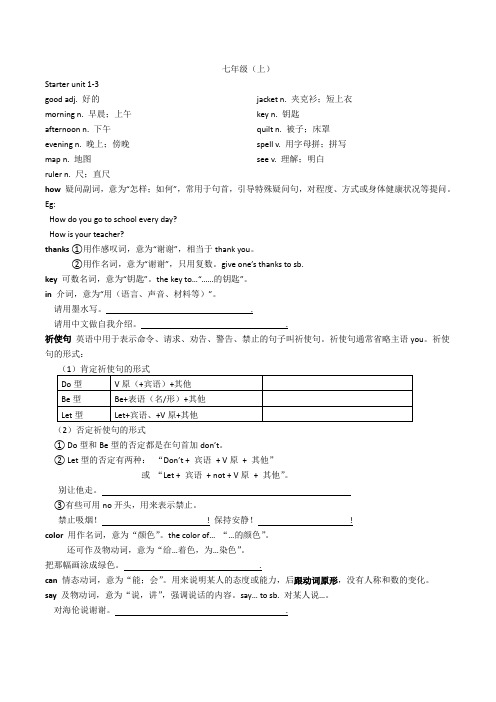
七年级(上)Starter unit 1-3good adj. 好的morning n. 早晨;上午afternoon n. 下午evening n. 晚上;傍晚map n. 地图ruler n. 尺;直尺jacket n. 夹克衫;短上衣key n. 钥匙quilt n. 被子;床罩spell v. 用字母拼;拼写see v. 理解;明白how疑问副词,意为“怎样;如何”,常用于句首,引导特殊疑问句,对程度、方式或身体健康状况等提问。
Eg:How do you go to school every day?How is your teacher?thanks①用作感叹词,意为“谢谢”,相当于thank you。
②用作名词,意为“谢谢”,只用复数。
give one’s thanks to sb.key可数名词,意为“钥匙”。
the key to…“……的钥匙”。
in介词,意为“用(语言、声音、材料等)”。
请用墨水写。
.请用中文做自我介绍。
.祈使句英语中用于表示命令、请求、劝告、警告、禁止的句子叫祈使句。
祈使句通常省略主语you。
祈使句的形式:(2)否定祈使句的形式① Do型和Be型的否定都是在句首加don’t。
② Let型的否定有两种:“Don’t + 宾语+ V原+ 其他”或“Let + 宾语+ not + V原+ 其他”。
别让他走。
③有些可用no开头,用来表示禁止。
禁止吸烟!! 保持安静!!color用作名词,意为“颜色”。
the color of…“…的颜色”。
还可作及物动词,意为“给…着色,为…染色”。
把那幅画涂成绿色。
.can情态动词,意为“能;会”。
用来说明某人的态度或能力,后跟动词原形,没有人称和数的变化。
say及物动词,意为“说,讲”,强调说话的内容。
say… to sb. 对某人说…。
对海伦说谢谢。
.no形容词,“没有;无”。
no +单数可数名词=not a/an +单数可数名词; no+不可数名词/复数名词=not any+不可数名词/复数名词。
七年级上册英语各单元知识点归纳

七年级上册英语各单元知识点归纳Unit 1 My name's Gina一、重点短语1. telephone/phone number电话号码2. first name=given name 名字3. last name=family name 姓4. middle school 中学5. in China 在中国6. my friend 我的朋友7. a piece of paper 一张纸二、重点句型1.—What’s your name?你的名字是什么?—My name's Gina. = I’m Gina.我的名字是吉娜/我是吉娜。
2. — Is she Mary? 她是玛丽吗?—Yes, she is./ No, she isn’t.是的,她是。
/不,她不是。
3.—Are you Helen? 你是海伦吗?—Yes, I am。
/ No, I’m not.是的,我是。
/不,我不是4. What's your name? 你叫什么名字?5. 我是玛丽。
I'm Mary.6. 遇见你很高兴。
Nice to meet you.7. 她的电话号码是多少?What's her telephone number?8.她姓什么?What's her last/family name?Unit 2 This is my sister.一、重点短语1. 他的姐姐his sister2. 我的哥哥my brother3. ······的名字the name of...4. 祝你度过愉快的一天Have a good day!15. 一张······的照片 a photo of...6. in the next picture 在下一张照片里7. in the first photo 在第一张照片里二、重点句型1. This/That is my friend Jane. 这是/那是我的朋友简。
英语七年级上册知识点
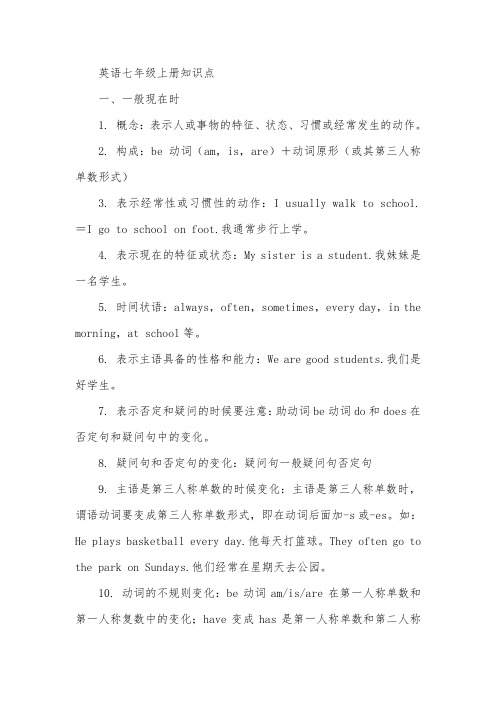
英语七年级上册知识点一、一般现在时1. 概念:表示人或事物的特征、状态、习惯或经常发生的动作。
2. 构成:be动词(am,is,are)+动词原形(或其第三人称单数形式)3. 表示经常性或习惯性的动作:I usually walk to school.=I go to school on foot.我通常步行上学。
4. 表示现在的特征或状态:My sister is a student.我妹妹是一名学生。
5. 时间状语:always,often,sometimes,every day,in the morning,at school等。
6. 表示主语具备的性格和能力:We are good students.我们是好学生。
7. 表示否定和疑问的时候要注意:助动词be动词do和does在否定句和疑问句中的变化。
8. 疑问句和否定句的变化:疑问句一般疑问句否定句9. 主语是第三人称单数的时候变化:主语是第三人称单数时,谓语动词要变成第三人称单数形式,即在动词后面加-s或-es。
如:He plays basketball every day.他每天打篮球。
They often go to the park on Sundays.他们经常在星期天去公园。
10. 动词的不规则变化:be动词am/is/are在第一人称单数和第一人称复数中的变化;have变成has是第一人称单数和第二人称单数和复数的变化;动词go和come的不规则变化;助动词do和does 的不规则变化。
二、现在进行时1. 概念:表示此时此刻正在进行的动作或存在的状态。
2. 构成:be动词(am,is,are)+动词的现在分词形式(ing)3. 表示正在进行着的动作:The boys are playing basketball now.男孩们正在打篮球。
We are having a class.我们正在上课。
4. 时间状语:now,at this time等。
七年级英语上册总复习知识点考点总结归纳
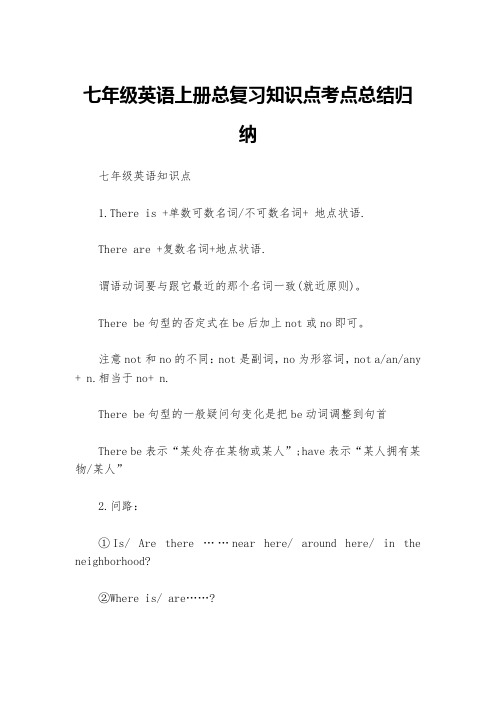
七年级英语上册总复习知识点考点总结归纳七年级英语知识点1.There is +单数可数名词/不可数名词+ 地点状语.There are +复数名词+地点状语.谓语动词要与跟它最近的那个名词一致(就近原则)。
There be句型的否定式在be后加上not或no即可。
注意not和no的不同:not是副词,no为形容词,not a/an/any + n.相当于no+ n.There be句型的一般疑问句变化是把be动词调整到句首There be表示“某处存在某物或某人”;have表示“某人拥有某物/某人”2.问路:①Is/ Are there ……near here/ around here/ in the neighborhood?②Where is/ are……?③How can I get to……?④Could/Can you tell me the way to……⑤Which is the way to……3.Across,cross,through,overAcross是介词,“横过,在对面”表示从物体表面穿过Cross是动词,相当于go/ walk acrossThrough是介词,表示从物体中间或里面穿过 go through the doorOver是介词,“横过,越过”表示从物体上空越过,跨过 fly over4.ask for help/ advice5.in/ on the street6.在某条大街上习惯用介词on on Bridge Street7.across from,next to,between…and…,behind8.in front of在…(外部的)前面→behind在…后面 in the front of在…(内部的)前面9.be in town→be out of town10.be far from11.go/ walk along go straight go up/ down12.turn left/right13.on one’s/ the left14.at the first crossing/ turning15.sometimes 有时(频度副词)sometime(将来)有朝一日,(曾经)某天Some times 几次,几倍 some time 一段时间(前面用介词for) 16.free空闲的 free time自由的 as free as a fish免费的 The best things in life are free.17.enjoy doing18.Time goes quickly.19.表“一些”在肯定句中用some.在疑问句和否定句中用any。
新版人教版七年级英语上册各单元知识点

空间
form Monday to Friday 从周一到周五
form Beijing to Shanghai 从北京到上海
6.finish的用法
finish作不及物动词时,意为“完成;做好”
They start work early and finish late every day.他们每天开工早收工晚。
作及物动词,后接动词时,要用动名词形式,即finish doing sth. 表示“做完某事,
完成某事”
Jim usually finishes doing his homework before 8:00.吉姆通常在8点前做完作业。
7.thank sb for的用法:
thank sb for意为“因……而感谢某人”,for是介词,后接名词、代词或动名词,表感
谢的原因或内容。
Thank him for telling me. 谢谢他告诉我。
Thank you for helping with my English.多谢你帮我学英语。
8.for two hours的用法:
“for+一段时间”是介词短语,意为“……时间”,表示某事持续多长时间。
对其提问要用
how long
—How long will you stay in Beijing 你将在北京待多长时间?
—For about three days. 大约三天。
七年级上册英语一至三单元知识点

七年级上册英语一至三单元知识点一、重点单词和词组1.nice漂亮的令人愉快的That’ a nice bag.那是一个漂亮的书包XXX.见到你很高兴2.lookvt.看;望;看起来vi.不及物动词Look!That apple is big.看那个苹果好大啊。
XXX看着某物/某人Look at the picture.看着这幅图片。
Look at the boy。
He is cool.看这个男孩。
他很酷。
Look at the blackboard。
There is a nice picture on it.看黑板。
有一张漂亮的图片在黑板上。
3.telephone电话,电话机Is this your XXX这是你的电话吗XXX德律风号码XXX你的电话号码是多少4.XXX回答,答复XXX回答问题XXX.请接电话。
XXX的谜底XXX题目的谜底5.first第一的反义词last最后的,上一个的。
first name名字last name姓氏last year客岁三重点句型和表达1.What’s your/her/his name My/Her/His name is…2.I’m….3.Nice to meet you.4.XXX It’s….5.What’s your family/lastname1.What’s your name用来询问对方姓名的日常用语,回答My name is…/I am…。
更为礼貌的询问别人姓名的方法还有May I know your name please?/ Could you tell me your name?2.问候⑴XXX早上/下战书/早晨好⑵Hello /Hi是熟人或朋友间常用的打招呼方式⑶How are you回覆I’m fine thank you.反问对方And you /How about you?⑷Nice to meet you.熟悉你很兴奋。
还能够说Glad to meet you.⑸How do you do用于初度晤面是十分正式的打号召。
新版七年级上册英语一至三单元知识点
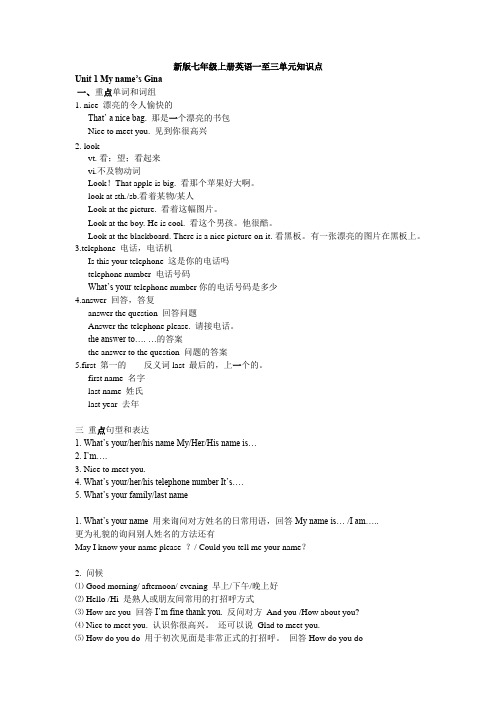
新版七年级上册英语一至三单元知识点Unit 1 My name’s Gina一、重点单词和词组1. nice 漂亮的令人愉快的That’ a nice bag. 那是一个漂亮的书包Nice to meet you. 见到你很高兴2. lookvt. 看;望;看起来vi.不及物动词Look!That apple is big. 看那个苹果好大啊。
look at sth./sb.看着某物/某人Look at the picture. 看着这幅图片。
Look at the boy. He is cool. 看这个男孩。
他很酷。
Look at the blackboard. There is a nice picture on it. 看黑板。
有一张漂亮的图片在黑板上。
3.telephone 电话,电话机Is this your telephone 这是你的电话吗telephone number 电话号码What’s your telephone number你的电话号码是多少4.answer 回答,答复answer the question 回答问题Answer the telephone please. 请接电话。
t he answer to…. …的答案the answer to the question 问题的答案5.first 第一的反义词last 最后的,上一个的。
first name 名字last name 姓氏last year 去年三重点句型和表达1. What’s your/her/his name My/Her/His name is…2. I’m….3. Nice to meet you.4. What’s your/her/his telephone number It’s….5. What’s your family/last name1. What’s your name 用来询问对方姓名的日常用语,回答My name is… /I am…..更为礼貌的询问别人姓名的方法还有May I know your name please ?/ Could you tell me your name?2. 问候⑴ Good morning/ afternoon/ evening 早上/下午/晚上好⑵ Hello /Hi 是熟人或朋友间常用的打招呼方式⑶ How are you 回答I’m fine thank you. 反问对方And you /How about you?⑷ Nice to meet you. 认识你很高兴。
七年级上册英语知识点归纳总结

七年级上册英语知识点归纳总结一、词汇与短语1. 基本词汇- 问候语:hello, hi, good morning/afternoon/evening- 常见颜色:red, blue, green, yellow, black, white, pink- 数字:one to ten, first to twelfth (for months and dates) - 常见动物:cat, dog, bird, fish, elephant, tiger- 家庭成员:mother, father, sister, brother, grandmother, grandfather2. 学校相关词汇- 学科:English, math, science, history, art, P.E. (physical education)- 学校设施:classroom, library, gym, cafeteria, office- 学习用品:book, pen, pencil, eraser, ruler, backpack3. 日常活动与习惯- 活动:play, read, write, listen, watch, eat, drink- 习惯:brush teeth, wash face, take a shower, go to bed4. 常见食物与饮料- 食物:apple, banana, orange, bread, rice, chicken, fish- 饮料:water, milk, juice, tea, coffee5. 常见形容词- 大小:big, small- 形状:round, square, long, short- 颜色相关:red, blue, green, yellow, etc.- 情感:happy, sad, angry, excited二、语法要点1. 时态- 一般现在时:表示经常发生的动作或状态,使用动词原形。
七年级上册英语知识点全集

七年级上册英语知识点全集七年级上册英语是英语学习的入门课,在这个阶段,学生需要掌握英语的基础知识和表达方式。
以下是七年级上册英语知识点全集。
一、基本语法1.简单的一般现在时:表示经常性或习惯性动作。
例如:I always get up at 6 o'clock.(我经常六点钟起床。
)2.疑问句的构成:(1)一般疑问句:助动词+主语+动词原形。
例如:Do you like playing basketball?(你喜欢打篮球吗?)(2)特殊疑问句:特殊疑问词+一般疑问句的构成。
例如:What do you usually do on weekends?(你周末通常做什么?)3.动词的三单形式:第三人称单数的动词要加-s或-es。
例如:He walks to school every day.(他每天走路去上学。
)4.情态动词的用法:情态动词用于表示可能性、推测、请求、建议等。
例如:You should go to bed early.(你应该早点睡觉。
)5.被动语态:主语变为动作的承受者,动词用过去分词形式,并在前面加上be动词。
例如:The book was written by him.(这本书是他写的。
)二、词汇1.表示时间和日期的基本词汇:时间:hour(小时)、minute(分钟)、second(秒钟)日期:date(日期)、month(月份)、year(年份)例如:What's the date today?(今天是几号?)2.日常生活中的常用词汇:例如:breakfast(早餐)、lunch(午餐)、dinner(晚餐)、homework(家庭作业)、classmate(同班同学)3.学校活动的相关词汇:例如:assembly(全校集会)、sports day(运动会)、Christmas party(圣诞派对)4.国家、语言和国籍的常用词汇:例如:China(中国)、Chinese(中文的、中国的、中国人)、Japan(日本)、Japanese(日语的、日本的、日本人)三、阅读理解及写作1.理解文章大意并回答问题:通读整篇文章,找出关键词并理解文章大意。
仁爱英语七年级上册知识点归纳完整版
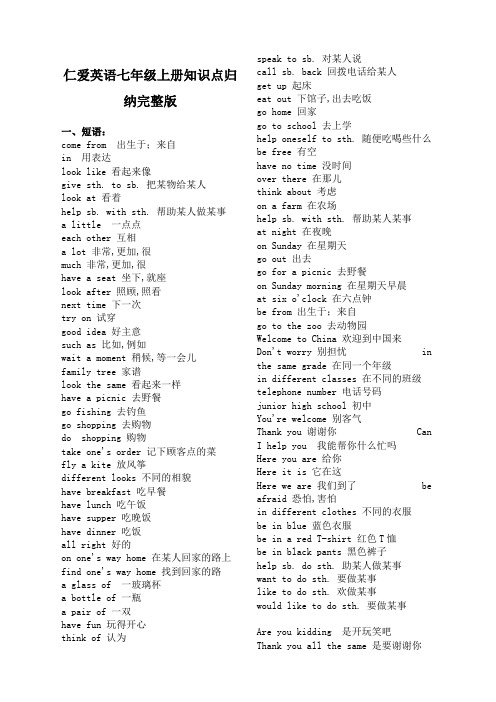
仁爱英语七年级上册知识点归纳完整版一、短语:come from 出生于;来自in 用表达look like 看起来像give sth. to sb. 把某物给某人look at 看着help sb. with sth. 帮助某人做某事a little 一点点each other 互相a lot 非常,更加,很much 非常,更加,很have a seat 坐下,就座look after 照顾,照看next time 下一次try on 试穿good idea 好主意such as 比如,例如wait a moment 稍候,等一会儿family tree 家谱look the same 看起来一样have a picnic 去野餐go fishing 去钓鱼go shopping 去购物do shopping 购物take one's order 记下顾客点的菜fly a kite 放风筝different looks 不同的相貌have breakfast 吃早餐have lunch 吃午饭have supper 吃晚饭have dinner 吃饭all right 好的on one's way home 在某人回家的路上find one's way home 找到回家的路a glass of 一玻璃杯a bottle of 一瓶a pair of 一双have fun 玩得开心think of 认为speak to sb. 对某人说call sb. back 回拨电话给某人get up 起床eat out 下馆子,出去吃饭go home 回家go to school 去上学help oneself to sth. 随便吃喝些什么be free 有空have no time 没时间over there 在那儿think about 考虑on a farm 在农场help sb. with sth. 帮助某人某事at night 在夜晚on Sunday 在星期天go out 出去go for a picnic 去野餐on Sunday morning 在星期天早晨at six o'clock 在六点钟be from 出生于;来自go to the zoo 去动物园Welcome to China 欢迎到中国来Don't worry 别担忧 in the same grade 在同一个年级in different classes 在不同的班级telephone number 电话号码junior high school 初中You're welcome 别客气Thank you 谢谢你 Can I help you 我能帮你什么忙吗Here you are 给你Here it is 它在这Here we are 我们到了 be afraid 恐怕,害怕in different clothes 不同的衣服be in blue 蓝色衣服be in a red T-shirt 红色T恤be in black pants 黑色裤子help sb. do sth. 助某人做某事want to do sth. 要做某事like to do sth. 欢做某事would like to do sth. 要做某事Are you kidding 是开玩笑吧Thank you all the same 是要谢谢你a bag of一袋That's right没错That's all right不用谢没关系 how many多少how much多少 too heavy太重this Sunday这个星期日forget to do sth.忘记去做某事See you later再见 's up怎么啦's wrong with you你怎么啦 have to 不得不carry water提水sing a song唱歌be in在家be out在外面ask sb. to do sth.要求某人做某事want sb. to do sth.想要某人去做某事would like sb. to do sth.想要某人去做某事at my home在我家What time is it几点了half past seven七点半a quarter to eight差一刻八点It's time to do sth.该做某事的时候了; What's the time几点了thank sb. for sth.因为某事而感谢某人thank sb. for doing sth.感谢某人做了某事 at the zoo在动物园二、知识点:Unit 11、Good morning/ afternoon / evening 早上/下午/晚上好 Good night 晚安2 、glad / nice to meet / see you 见到你很高兴回答也一样3、welcome to + 地点欢迎来到答:Thank you 或者 Thanks4、let’s + V原让我们做5、 stand up 起立 sit down 坐下6、this is 这是…… 用于介绍第三者的用语7、How do you do 你好回答也是:How do you do 8、 How are you 你好吗 Fine ,thank you .and you 很好;谢谢;你呢I’m OK / I’m fine , too . 我也很好;9、 see you = see you later = see you soon = good-bye 再见10、 excuse me 打扰一下;请问11、I’m = my name is 我是……12、 be from = come from 来自13、 in English 用英语14、 Can you spell it Yes / No 你能拼写它吗能/不能15、That’s OK / That’s all right / You’re welcome / Not at all 不用谢16、…… years old ……岁17、 telephone number 电话号码number 号码 ID number 身份证18、 the same 相同的反义词是different 不同的例: We are in the same grade, but we are in different classes. 句型:19、What is your name 你的名字是什么20、Where +be + 主语 + from 某人来自于哪里回答:主语+be+地点例: Where are you fromI am from quanzhou.21、How old + be + 主语某人几岁回答:主语 + be + 数字例:How old are you I’m forteen.22、What is your telephone number 你的电话号码是多少回答:My telephone number is或者It’s 注意:读出号码的时候要逐个读出;23、What class / grade +be + 主语 + in 某人在哪一个班级/年级例:what class are you in I am in Class Five. 注意:Class 和 Five 需要大写what grade are you in I am in Grade Seven. 注意: Glass 和 Seven 需要大写 24、What’s this/ that in English 这是什么回答:It’s a/an + 单数名词. 这是…… What’ re these/ those in English 这些是什么回答:They’re + 复数名词这些是……25、How do you spell it 你怎么拼写它 E-R-A-S-E-R, eraser. 注意拼读方法Unit 2 1、 sb + has/ have an /a + adj + 五官 === sb’s 五官 is / are + adj 描述长相例:Lily has a small nose. = Lily’s nose is small. 2、 I know = I see 我明白了 3、That’s right 那是对的 4、look the same look like 看起来相像look different 看起来不同例: Jim and Lilei look the same.== Jim looks like Lilei. . 5、 look at + n 看某物 look for +n 寻找某人/某物 look after +n 照顾某人 6、 both 两者都…… all 三者或者三者以上都Both 和all 位于 be 动词或情态动词后,位于行为动词前;例: We are both students. We both have black eyes. We can both speak English. 注意: 7、 give sth to sb = give sb sth 把某物给某人;注意:如果 sth 是 it 或 them,只能用前者注意 ,只能用前者8、 have different looks == look different 有着不同的长相看起来不相像have the same look. ==look the same 有着相同的长相看起来很相像 9、over there 在那边 come in 请进 go out 出去 10、 in + 颜色或 in a/an/the +颜色 + 衣服表示穿着……颜色的衣服常常接在名词的后面,表示穿颜色衣服的…… 如 the girl in red is my sister.11、 too + adj 太……12、 pants 和shoes 做主语,谓语动词用复数;但 a pair of pants/ shoes 作主语时,谓语动词用单数形式例: His shoes are black. A pair of shoes is under the bed. 13、 in the morning/ afternoom/ evening 在早上/下午/晚上 at night 在晚上 14、 go shopping = go to the shop 去购物类似的有 go swimming go fishing go skating 等等帮助某人做某事注意:sb 用代词时必须用宾格 15、 help sb. to do sth == help sb with sth 16、 high school 中学 17、 play +球类 play the 乐器 18、 think of 认为,想 think about 考虑 I think + 从句我认为……例: I think he you are right.否定式常否定主句,但翻译时要否定后面的从句例:I don’t think he can come. 我认为他不会来了.不能说:我不认为他会来19、What do/does + 主语 + look like 询问人的长相例: What does your English teacher look like 20、What’s and ……加……是什么回答:It’s例:What’s red and yellow It’s orange. What’s two and five It’s seven. 21、Whose + 东西 + is this/ that Whose + 东西 +are these/ those 这/这些是谁的……例:Whose coat is this It is mine. Whose shoes are these They are hers.22、Who is the letter from 这封信来自于谁It’s f rom Lily. 它来自于莉莉;23、What color be + 东西回答:It’s +颜色或者They’er + 颜色例:What color is your dress It’s black.Unit 31、Could you please…… 后接动词原形你愿意做某事吗我能做某事吗 MayI …… 后接动词原形2、 the English corner 英语角3、 live in + 地点住在某地 live with + 人和某人住在一起4、 What does he say in the letter 他在信里说了些什么 What does he say on the phone 在电话里说了些什么5、 a lot = very much 放在句末,修饰动词,非常……not at all 一点也不……例: I like the boy a lot/ very much.I don’t like the boy at all.. 6、 each other 相互,彼此例: S tudents often talk to each other in class. 7、 do sth with sb 和某人一起做某事 8、 No problem 没问题9、 speak + 语言说某种语言 speak English speak Chinese 10、 the Great Wall 长城 11、 come/go to + 地点去某地但 home 、 here 、 there 这些是副词,前面不能加 to例:go home / come here / go there go to do sth 去做某事例: They go to play basketball. 12、 like doing sth 喜欢做某事 like to do sth 想要做某事 13、It’s + adj +to sb 对某人来说是……的 14、 help sb with sth =help sb to do sth 帮助某人某事 15、 be at home = be in 在家 go home 回家 get home 到家in one’s home 在某人的家里 16、 have a seat / take a seat / sit down 请坐下 17、office worker 办公室职员 cook 厨师cooker 炊具 18、 on a farm 在农场上on the sofa 在沙发上 19、 a photo of one’s family 某人的全家照 Family Tree 家谱首字母都大写 20、 in a hospital 在医院纯属地点概念 in hospital 因病住院例:He is ill in hospital. 他生病住院 He is in a hospital.他在医院里不一定是因为生病来到医院 21、 look after sb = take care of sb 照顾某人22、 teach sb sth = teach sth to sb 教某人某东西 teach sb to do sth 教某人做某事23、help oneself to sth. 请随便吃…… help yourself/ yourselves to fish24、I’d like sth = I would like sth. 我想要……25、 Would like to do sth = want to do sth 想要做某事26、 Would you like something to eat drink 你想要一些吃喝的东西吗 to eat 或 to drink 修饰 something,作为后置定语; 27、 Here you are . 给你 Here we are. 我们到了28、What about …… == Howabout …… ……怎么样后接代词或名词,还可以接动名词即What about doing sth29、 all right 好的30、a cup of tea 一杯茶 two cups of tea 两杯茶31、 milk for me 我要牛奶32、Why not ……后接动词原形 = Why don’t you …… 后接动词原形为什么不做某事呢回答:Good idea 好主意;33、 May I take your order 可以点菜了吗34、 wait a moment = just a moment 等一下,请稍侯 wait for sb 等待某人35、 Can I help you = May I help you = What can I do for you 需点什么帮忙吗36、 eat out 出去吃饭37、 let sb do sth 让某人做某事38、 have dinner/ breakfast/lunch/supper 吃正/早/午/晚餐39、 a kind of 一种…… all kinds of 各种各样的……40、be friendly/kind to sb 对某人友好41、 such as 例如例:I like fruits, such as oranges,bananas and apples42、 be glad to do sth例: I am glad to meet you, I am glad to be here.. 句型:43、What do/does + 主语+ do == What +be+ 主语. == What’s one’s job 回答:主语 + be + 职业.例如: What does your father do = What is your father = What’s your father’s job He is a teacher.Unit 41、 try on 试穿……2、 we/I will take it 我们/我买下了这里的 take 相当于 buy3、 buy sth for sb = buy sb sth给某人买某物; 4、I’m just looking 我只是看看; 5、 three hundred and sixty-five 365 百位数和十位数之间加and , 十位数和个位数之间加”-“6、 a pair of 一对/一双……7、 running shoes 跑鞋8、 Are you kidding 你开玩笑吧;9、 think about 考虑;10、 thank you all the same 仍然谢谢你;11、 Is that all 就这么多吗That’s all. 就这么多吧 I12、 I think so. 我认为是这样的. I don’t think so.我认为不是这样的. 13、当把东西给某人时可以说: Here you are 或 Here be + 东西或 Here it is.14、Don’t worry.别担心① worry about + 宾语如:Do you worry about your leesson ②Worried 烦恼的 be worried about +宾语如:She is worried about her mother.15. a few +可数名词肯定一点,一些;;few + 可数名词:否定几乎没有 alittle +不可数名词肯定一点,一些;;little + + 不可数名词:否定几乎没有16、 be free = have time 有空的;反义词:be busy = have no time Are you free tomorrow == Do you have time tomorrow17、在某一天使用介词 on , 在某个时刻用 at 如:On Sunday at a half past six 当 this 接时间,不用介词, this Sunday18、What’s up = what’s wrong = What’s the matter 什么事19、 forget to do sth. 忘记去做某事事还没做 forget doing sth 忘记曾做过某事事已做完20、 tell sb about sth. 告诉某人某事tell sb sth = tell sth to sb 把某事告诉某人 ask/tell sb to do sth 叫某人做某事 ask/tell sb not to do sth 叫某人不要做某事21、电话用语:①Who’s this 你是哪位②Is this ……你是……吗③This is ……speaking 我是…… ④May I speak to……我可以找……吗 22、go for sth = go to do sth 去做某事如: go for class = go to have class.23、It’s fun 真是有趣的事24、 call sb = give sb a call 打电话给某人 call sb back 给某人回电话25、I’m afrai d /sorry that + 从句恐怕……/ 对不起,……26、I have no time = I don’t have any time 我没有时间 no = not any27、 be not in = be not at home = be out 出去了,不在家;28、 sing a song / sing some songs 唱歌; fly a kite 放风筝;draw picture 画画 play sports 做运动; watch TV 看电视 read books 看书 read newspaper 看报纸29、 let sb do sth 后接动词原形让某人做某事30、时间读法有顺读法和逆读法:顺读法eleven thirty-six 表示 11:36 逆读法分钟数小于等于 30 分用 past , 分钟数大于 30 分用 to,如 five past ten 表示 10:05; five to ten 表示 9:55,half past six 表示 6:30 , a querter to six 表示 5:4531、 show sth to sb = show sb sth 把……拿给某人看;作为名词表示演出,表演32、祈使句的否定句,直接在句首加上Don't 就可以了33、have to ……后接动词原形不得不……34.、It’s time for sth/ doing sth It’s time to do sth 该到做……的时候了It’s time for sb to do sth 是某人做某事的时候了35、 next time 下一次 next week 下个星期 the next day 第二天;36、next to…… = near…… 在……旁边37、 get up 起床 go to bed 上床睡觉;get sb up 叫某人起床38、do one’s homework 做作业;39、 have a picnic 野餐;have class 上课 have a meeting 开会 have a party 举办聚会 have dinner/ breakfast/lunch/supper 吃正/早/午/晚餐 have +东西吃/喝……have a good time =enjoy oneself 玩得很愉快 have sb to do sth 让某人做某事 have to do sth 不得不……40、on the weekday 在周末;41、lot of = lots of = many =much 许多的,大量的42、 in the sun 在阳光下;43、sb like best = sb’s favorite + 种类is / are …… 谁最喜欢…… 44、on one’s way to 在某人去……的路上;on one’s w ay home 在某人回家的路上45、 Here we are. 我们到了46、It’s very kind of you 你真是太好了;47、 thanks / thank you for + n /v-ing 为……而感谢你;48、 in the tree 在树上外物附着 on the tree 在树上树上本身长出的东西 In the wall 在墙里如 window on the wall 在墙上49、 What do you think of = How do you like 你认为……怎么样例:What do you think of your English teacher= How do you like your English teacher 50、 How much be + 主语回答:It’s / They’re + 价钱. How much is your English book 问价格还可以用what’s the price of …… 为什么不做某事呢 51、Why not ……后接动词原形= Why don’t you …… 后接动词原形回答:Good idea 好主意;52、 What time is it == What is the time 回答:It’s +时间考点归纳:1、英文中常用的问候语及其回答:-Hello. -Hello.—Hi. —Hi—Good morning. —Good morning.—Good afternoon. —Good afternoon. —Good evening. —Good evening. —Good night. —Good night.—How do you do —How do you do—How are you —Fine, thank you.注意:对“How do you do” 和“How are you” 两句话的回答不要弄混淆; 2、sorry “对不起” 用于引出某一过错; Excuse me. “对不起” 用于引起对方的注意;例如:I’m sorry I can’t speak English. Excuse me, is this your backpack3、be late for ... 做……迟到 be late for school/ class/ work/ the meeting 上学/上课/上班/开会迟到注意: late 的副词仍为 late, 不能写成 lately.例如:请不要晚到学校; Please don’t arrive lately for school. × Please don’t arrive late for school. √ 4、见到某人很高兴的几种表达:Nice to meet you. = Happy/ Glad/ Pleased to meet you.5、What’s this in English =What’s the English for this 这个用英语怎么说用什么语言,介词用in: “in + 语言”.例如: in English 用英语 in Chinese 用汉语 in Japanese 用日语注意:用钢笔:in ink = in pen = witha pen 让我们学英语;6、Let’s learn English. 让我们学英语;L et’s = let us 让我们Let’s do sth. = Why not do sth. = What/How about doing sth.如:Let’s learn English. = Why not learn English = What/How about learning English注意:let sb. do .. 中的 sb.即使是第三人称单数后面的动词仍用原形例如:Let her sing an English song.7、learn from 向……学习 learn to do sth. 学做……例如:Let us learn fromLei Feng. Lucy learns to play the guitar.8、对颜色提问的两种方法: Whatcolor … = What’s the color of … 例如: What color is your coat = What’s the color of your coatcolor 着色 color sth. + 颜色,例如: I want to color it red.color 是可数名词例如:I don’t like these colors.9、对姓名的几种提问及回答:What’s your name = May I have/know your nameMy name is … = I’m…10、call + sb. + at + … “给某人打电话”11、感谢你:Thanks. = Thank you. √ Thank. × Thanks you. × Thanks for + sth./doing sth. 为……而感谢你;例如:Thanks for your help. =Thanks for helping me.12、take, bring, carry 和 get 的区别:1take “带走”,从近处带到远处例如:Please take these books to your home after school.2 bring “带来”,从远处带来例如:Please bring me some cakes.3c arry “带”,无方向性,指移动较重、较大的东西,有“负重”的含义例如:The bag is too heavy for me. Can you carry it for me 4 get “去拿来”,相当于 go and bring例如:Can I get you something to drink 12、need 需要1 need + V原……” 例如:She need some cakes.2 need to do sth. “需要做……”例如:She needs to speak English often.13、There be 句型在某处有什么例如: There is a clock on the wall. There be 句型的就近原则:若有两个或两个以上的主语是,谓语常与靠近它的那个主语一致;例如:There is a book, two pens and some cups on the desk.There are two pens, some cups and a book on the desk.注意:There be与 have 的区别在于:have 表示某人或某物拥有什么;而There be 表示在什么地方存在什么; 14、want to do sth. “想要做……”例如:He wants to join the reading club.15、like v. 喜欢用法:like sth. / sb. 喜欢…like doing sth. 喜欢做…like to do sth. 想做…like sb. to do sth. 想要某人做…would like to do sth.想做… be like 像…look/sound like 看/听起来像…注意:like doing sth. 喜欢做…长期的喜好,习惯like to do sth. 想做…短期的,具体的某一次活动16、构词法:在动词后面加-er 或-or,将动词变为人的名词例如: sing-singer wait-waiter work-workerteach-teacher speak-speakervisit-visitor加-r: write-writer drive-driver双写尾字母: run-runnerswim-swimmer shop-shopper注意: cook烹调— cook 厨师-cooker 厨房用具17、a lot of = lots of 可以用来修饰可数名词和不可数名词;Jim drank a lot of/lots of beer. I have a lot of/lots of things to do. a lot 作状语,表示程度、数量或频率;例如:Thanks a lot. I know a lot about it.19、for 就……而言例如:I have some bread for supper.20、have/eat + 三餐“吃早/中/晚饭” 例如:I usually have lunch at home.21、对价格提问:How much …=What’s the price of …例如: How much is this sweater = What’s the price of this sweater 22、in + 颜色例如: She is in red. = She is in a red coat.\23、on, in, at 与时间状语连用: on + 具体某一天例如:I will do some shopping on Sunday.in + 时间段例如: in the morning / afternoon / eveningat + 几点例如:Our class is at 8:00注意:如果时间状语前面有这些词:this, that, next, tomorrow等, 则不用介词;例如: See you next time.24、对年龄的提问:How old are you What’s your age May I know/have your age 答:I’m ... years old. 注意:表达年龄的几个同义句: Tom is 15. =Tom is 15 years old. =Tom isa 15-year-old boy. =Tom is a boy of 15.25、think +句子例如:I think you are right.注意: think 的否定转移例如:I don’t think it is right.26、like ... best = favorite+…最喜欢…例如:Jack likes red best. =Jack’s favorite color is red.27、too/also/either的区别:too 用于句末例如: Tom is from America. Lucy is from America, too. also 用于句中be 动词后,行为动词前例如: Tom is from America. Lucy is also from America. either 用于否定句中例如:Tom isn’t from America. Lucy isn’t from America, either.28、speak/ say/ talk/ tell 的区别:speak+语言讲某种语言例如:She can speak Chinese. I can speak a little English. say 强调说话的内容例如:Let me say “Thanks” to you. talk 强调交谈:talk to/with ….和……交谈talk about … 谈论……tell 强调“告诉”:tell sb. sth. = tell sth. to sb.注意:say 还有“写着”的意思,例如:Look There is a card. It says “CLOSED”. 29、be good to 对…… 友好= be friendly/kind to…30、help oneself 随便吃……在使用时要注意反身代词的单复数;例如:Jim, help yourself, please. Help yourselves, boys. help sb. = give sb. a hand 帮助……help sb. with sth. 帮助某人做某事例如:Can you help kids with swimming 你能帮助孩子学游泳吗31、动词+介词构成的动词短语,其宾语是名词的时候,可放在动词与介词之间,也可以放在介词的后面例如: call sb. back = call back sb. 给……回电话 try sth on. = try on sth. 试穿……注意:如果宾语是代词 it 或 them 则只能放在中间例如:try it/them on.32、allof 全部,所有三者以上; bothand 两者都……放在助动词、情态动词、be 动词之后,行为动词之前例如:We are all students, we all work hard.My parents are both office workers.= Both my father and mother are office workers.All of the girls look nice.33、be from = come from…来自…… 注意:动词的变化: She’s from China. = She comes fromChina.She isn’t from England. = She doesn’t come from England.常见的错误: Where is he come from Where does he from国籍的几种表达方法: Tom 是个美国人;Tom is American. Tom is an American. Tom is an American boy. Tom is from America. Tom comes from America.售货员招呼顾客:① May I help you ② Can I help you③ What can I do for you ④ What would you like顾客常用语: ① No, thanks. I’m just looking . ② I’m looking for ... . ③ I’d like to have/buy ... . ④ Can you show me ...⑤ Could I have a look at ...询问顾客想买东西的特征: ① What kind would you like② What color would you like ③ What color would you like顾客询问价格: ① How much is itare they②What’s the pr ice of ...顾客决定要买:I’ll take/have itthem. 付钱: Here’s the money.。
2024新版英语七年级上册知识点

2024年新版英语七年级上册知识点一、重点短语句型STARTER UNIT 1 Hello!1.starter unit 过渡单元2. sit down 坐下3. make up 编造4. each other 互相;彼此5. start a conversation 开始对话6. thank you 谢谢你7. go to class 去上课8. good morning 早上好1. It’s time for class. 上课时间到了。
2. What’s your name? 你叫什么名字?3. How do you spell your name? 你怎样拼写你的名字?4. How are you? 你好吗?5. Nice to meet you. 很高兴见到你。
6. May I have your name? 我可以知道你的名字吗?7. Oh, that’s the bell. 哦,铃声响了。
8. Let’s go to class. 让我们去上课吧。
STARTER UNIT 2 Keep Tidy!1.keep tidy 保持整洁2. talk about 谈论3. wake up 醒来4. get up 起床5. fly a kite 放风筝6. ride a bike 骑自行车7. come on 快点8. a pair of 一双/对9. wait a minute 等一会儿10. on the head 在头上11. under the desk 在书桌下面12. on the chair 在椅子上面1. What do you have in your schoolbag? 你的书包里有什么?2. What colour is it? 它是什么颜色的?3. Don’t get up too late! 不要起得太晚!4. Oh, here it is. 哦,它在这儿。
5. You need to keep your room tidy. 你需要保持你的房间整洁。
七年级上册英语知识点 (全册)

七年级上册英语知识点 (全册)1. 单元一:Hello, my name is.a. 重点词汇:- Hello: 问候语- Good morning: 早上好- Good afternoon: 下午好- Good evening: 晚上好- My name is: 我的名字是- How are you?: 你好吗?- I'm fine, thank you. And you?: 我很好,谢谢。
你呢?- Goodbye: 再见b. 重点句型:- Introducing yourself: 介绍自己- Hello, my name is [name]. I'm from [country/city].- Asking for introduction: 询问对方介绍- Nice to meet you. Can you introduce yourself?2. 单元二:What's your name?a. 重点词汇:- What's your name?: 你的名字是什么?- My name is: 我的名字是- How old are you?: 你多大了?- I'm 12 years old: 我12岁- Where are you from?: 你来自哪里?- I'm from China: 我来自中国b. 重点句型:- Asking someone's name and age: 询问某人的名字和年龄- What's your name? My name is [name]. How old are you? I'm [age] years old.- Introducing your friends: 介绍你的朋友- This is my friend [name]. She/He is [age] years old.3. 单元三:Hello, how are you?a. 重点词汇:- Hello: 问候语- How are you?: 你好吗?- I'm fine, thank you. And you?: 我很好,谢谢。
初中英语人教新目标七年级上册知识点(重点句子+句式+词组)
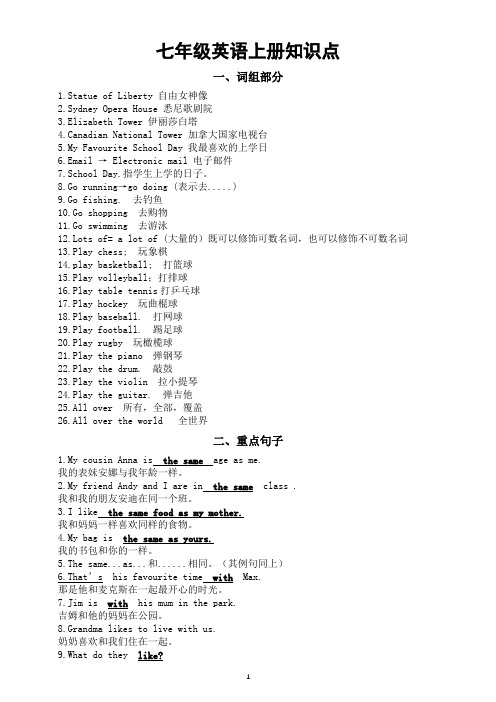
七年级英语上册知识点一、词组部分1.Statue of Liberty 自由女神像2.Sydney Opera House 悉尼歌剧院3.Elizabeth Tower 伊丽莎白塔4.Canadian National Tower 加拿大国家电视台5.My Favourite School Day 我最喜欢的上学日6.Email → Electronic mail 电子邮件7.School Day.指学生上学的日子。
8.Go running→go doing (表示去.....)9.Go fishing. 去钓鱼10.Go shopping 去购物11.Go swimming 去游泳12.Lots of= a lot of (大量的)既可以修饰可数名词,也可以修饰不可数名词13.Play chess; 玩象棋14.play basketball; 打篮球15.Play volleyball;打排球16.Play table tennis打乒乓球17.Play hockey 玩曲棍球18.Play baseball. 打网球19.Play football. 踢足球20.Play rugby 玩橄榄球21.Play the piano 弹钢琴22.Play the drum. 敲鼓23.Play the violin 拉小提琴24.Play the guitar. 弹吉他25.All over 所有,全部,覆盖26.All over the world 全世界二、重点句子1.My cousin Anna is the same age as me.我的表妹安娜与我年龄一样。
2.My friend Andy and I are in the same class .我和我的朋友安迪在同一个班。
3.I like the same food as my mother.我和妈妈一样喜欢同样的食物。
4.My bag is the same as yours.我的书包和你的一样。
七年级上册英语全部知识点总结

七年级上册英语全部知识点总结一、词汇1. 问候语:hello, hi2. 人名:Alice, Bob, Cindy, Dale, Eric, Frank, Grace, Helen3. 指示代词:this, that4. 人称代词:I, you, he, she, it5. 形容词性物主代词:my, your, his, her6. 名词:pen, pencil, book, eraser, ruler, schoolbag, dictionary, teacher, student, classroom7. 动词:be (am, is, are)8. 数词:zero, one, two, three, four, five, six, seven, eight, nine9. 颜色:red, yellow, green, blue, black, white, purple, brown10. 家庭成员:mother, father, parent, sister, brother, grandmother, grandfather, grandparent, family二、语法1. 一般现在时- 定义:表示经常发生的动作或存在的状态。
- 构成:主语 + be (am/is/are) + 其他;主语 + 实义动词 + 其他- 例句:I am a student. He plays basketball every day.2. 人称代词和物主代词- 人称代词主格:I, you, he, she, it, we, they- 人称代词宾格:me, you, him, her, it, us, them- 形容词性物主代词:my, your, his, her, its, our, their- 例句:She is my sister. This is his book.3. 指示代词 this 和 that- this 指较近的人或物,that 指较远的人或物- 复数形式:these(这些),those(那些)- 例句:This is a pen. That is a ruler.4. 名词的单复数- 一般情况在词尾加 -s,如:book - books- 以 s, x, ch, sh 结尾的名词加 -es,如:box - boxes- 以辅音字母 + y 结尾的名词,变 y 为 i 再加 -es,如:family - families- 不规则变化:man - men, woman - women, child - children5. 介词 in, on, under- in 表示“在……里面”,如:in the bag- on 表示“在……上面”,如:on the desk- under 表示“在……下面”,如:under the chair6. 特殊疑问句- 以特殊疑问词开头的疑问句,常见的特殊疑问词有:what(什么), who (谁), where(哪里), how(怎样)等- 例句:What's your name? Where is my pen?三、句型1. 打招呼:- Hello! / Hi!- Good morning/afternoon/evening!- How are you? I'm fine, thanks.2. 介绍自己和他人:- I'm...- This is...3. 询问物品:- What's this/that in English? It's a/an...4. 确认物品所属:- Is this/that your...? Yes, it is. / No, it isn't.5. 询问颜色:- What color is it? It's...6. 表达拥有:- I have...- You have...四、语音1. 元音字母 a, e, i, o, u 的发音规则2. 常见的元音字母组合的发音,如:ai, ea, ee 等3. 辅音字母的发音4. 常见的辅音字母组合的发音,如:ch, sh, th 等五、写作1. 能够简单介绍自己和家人2. 描述物品的位置和颜色3. 用英语写简单的问候语和对话。
七年级英语上册知识点归纳
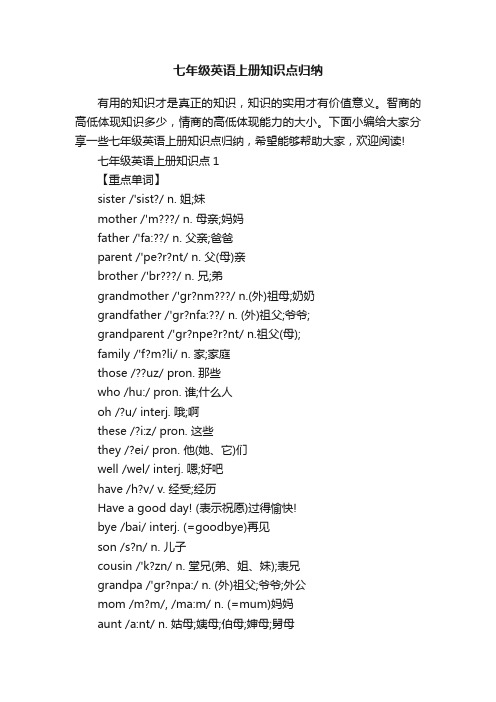
七年级英语上册知识点归纳有用的知识才是真正的知识,知识的实用才有价值意义。
智商的高低体现知识多少,情商的高低体现能力的大小。
下面小编给大家分享一些七年级英语上册知识点归纳,希望能够帮助大家,欢迎阅读!七年级英语上册知识点1【重点单词】sister /'sist?/ n. 姐;妹mother /'m/ n. 母亲;妈妈father /'fa:??/ n. 父亲;爸爸parent /'pe?r?nt/ n. 父(母)亲brother /'br/ n. 兄;弟grandmother /'gr?nm/ n.(外)祖母;奶奶grandfather /'gr?nfa:??/ n. (外)祖父;爷爷;grandparent /'gr?npe?r?nt/ n.祖父(母);family /'f?m?li/ n. 家;家庭those /??uz/ pron. 那些who /hu:/ pron. 谁;什么人oh /?u/ interj. 哦;啊these /?i:z/ pron. 这些they /?ei/ pron. 他(她、它)们well /wel/ interj. 嗯;好吧have /h?v/ v. 经受;经历Have a good day! (表示祝愿)过得愉快!bye /bai/ interj. (=goodbye)再见son /s?n/ n. 儿子cousin /'k?zn/ n. 堂兄(弟、姐、妹);表兄grandpa /'gr?npa:/ n. (外)祖父;爷爷;外公mom /m?m/, /ma:m/ n. (=mum)妈妈aunt /a:nt/ n. 姑母;姨母;伯母;婶母;舅母grandma /'gr?nma:/ n.(外)祖母;奶奶;外婆;dad /d?d/ n. 爸爸uncle /'??kl/ n. 舅父;叔父;伯父;姑父;舅父daughter /'d?:t?/ n. 女儿here /hi?/ adv. (用以介绍人或物)这就是;在这里photo /'f?ut?u/ n. 照片of /?v, ?v/ prep. 属于(人或物);关于(人或物)next /nekst/ adj.&n. 下一个(的);接下来(的)picture /'pikt??/ n. 照片;图画girl /g?:l/ n. 女孩dog /d?g/ n. 狗知识点:1.短语归纳:have a goodday 过得愉快a photo of …………的照片 in the first photo 在第一张照片上 in my family 在我的家庭里the name of ……的名字 a photo of my family 一张我的全家福 family tree 全家福(家族关系图) family photo 全家福2.典句必背:1. That is my family. 那是我的家庭。
- 1、下载文档前请自行甄别文档内容的完整性,平台不提供额外的编辑、内容补充、找答案等附加服务。
- 2、"仅部分预览"的文档,不可在线预览部分如存在完整性等问题,可反馈申请退款(可完整预览的文档不适用该条件!)。
- 3、如文档侵犯您的权益,请联系客服反馈,我们会尽快为您处理(人工客服工作时间:9:00-18:30)。
七年级英语上册所有知识点七年级英语上册是初中英语学习的起点,旨在帮助学生熟悉英语基本语法和词汇。
全册内容包括基本句型、日常用语、基础语法以及阅读理解等方面。
本文将详细介绍七年级英语上册所有知识点。
一、基本句型
1. 主语+谓语:Subject+Verb,例如:I speak English.
2. 主语+谓语+宾语:Subject+Verb+Object,例如:I like apples.
3. 主语+系动词+表语:Subject+Linking Verb+Predicate Adjective,例如:She is beautiful.
4. 主语+谓语+间接宾语+直接宾语:Subject+Verb+Indirect Object+Direct Object,例如:She gave me a book.
5. 主语+谓语+宾语+宾语补足语:Subject+Verb+Object+Object Complement,例如:I find the movie interesting.
二、日常用语
1. 问候语:Hello,Hi,Good morning/afternoon/evening,How are you?
2. 自我介绍:My name is…,I’m from…,Nice to meet you.
3. 交流:What’s your favorite color/food/animal?,Do you like…?,What do you do in your free time?
4. 邀请:Would you like to…?,Do you want to…?,Let’s go…
三、基础语法
1. 名词:Nouns,包括可数名词和不可数名词,例如:book,water。
2. 代词:Pronouns,包括人称代词、物主代词、指示代词、反
身代词、不定代词等,例如:I,my,this,yourself,anything。
3. 形容词:Adjectives,用来描述名词或代词的特征,例如:red,happy。
4. 副词:Adverbs,用来描述动词、形容词或其他副词的程度或方式,例如:slowly,always。
5. 介词:Prepositions,用来描述名词或代词与其他词之间的关系,例如:in,on。
四、阅读理解
1. 短文阅读:Short passages,包括对短文进行理解和回答问题等。
2. 填空题:Fill in the blanks,根据短文内容填空,以检测学生对单词和语法的掌握程度。
3. 选词填空:Multiple choice,根据提供的单词填空,以检测学生对单词语法的掌握程度。
总之,七年级英语上册所包含的知识点,包括基本句型、日常用语、基础语法和阅读理解等方面,旨在帮助学生打下英语学习基础,为进一步学习打下坚实的基础。
